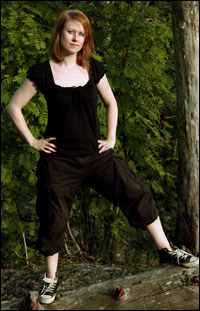A few days ago these absolutely amazing videos of Mariah's more showboat-y vocal runs appeared in my subscription feed. Her agility (and ability to maintain tonal quality and intonation at those speeds) is incredible.
Ordinarily in vocal showcase videos, if a great deal of notes are sung at once, the uploader will pick the note that is sustained the most or simply the peak note and use that. In these videos, though, he attempts to point out all the notes. He seems to be doing more, too:
Lead The Way
Butterfly
Can't Take That Away
Emotions
I kept watching trying to see how many of the pitch changes I could notice in the Butterfly clip. They go by so quickly. Haha.
If you are interested in the mechanics, you might find Bel Canto: A History of Vocal Pedagogy by James Stark very interesting. He uses Garcia as his guidepost, as Garcia was one of the first teachers in bel canto tradition to attempt to use the laryngoscope to check his ideas about the voice and how it works. It is pretty amazing how close he got on a lot of aspects and the educated guesses he made based on limited information. There's entire chapters on vibrato, appoggio, register breaks and types, issues of idiom and expression (articulation, floridity, trills, tempo rubato, categories of expressive song), chiaroscuro, coup de la glotte and so forth, with historical perspectives going back to the 1600s through the early 1900s, as well as modern views of these issues and then conclusions that sort of sum it up.
I actually quoted an excerpt from the book earlier that talks about belting; it talks about some of what you're saying. I know that it is possible to get the vibrato on belted notes (or at least, more of the note with vibrato than not, instead of the 'vibrato crescendo' only occurring at the tail end as Stark mentions), but I'm not sure how it is done. I have noticed that vocalists with a lot of control will be able to belt notes using vibrato in a variety of ways - eschewing it completely, having vibrato the entire time, using vibrato crescendo, varying the speed and intensity, and so forth. Actually, on the subject of speed it is mentioned that the conventional standards of vibrato speed in classical singing have changed and today we expect somewhat faster vibrato than we did before.
And you are entirely right that you shouldn't feel pain and shouldn't force anything to achieve something in singing, of course. I'm glad you mentioned supporting notes in the throat, as well, as it seems to be a rather common mistake in vernacular singing. I think that characterize proper belting as "free" is still accurate, because it seems to me that many of the problems relating to belting (placement, improper mixes (particularly too much chest), high larynx, squeezing the throat, tensing the jaw, and so forth all result in a lack of freedom. I think of the opposite of freedom in this situation as unnecessary tension, rather than intensity. Belting is a very intense way of vocalizing, but it still needs to be done so the voice is free to ring. I hope I'm making sense.
I liked the Writing on the Wall performance, though I agree with you that the audio quality is terrible. I also am noticing now that I've been listening to a lot of it today that musical theater singing isn't as much my cup of tea as a general - I'm impressed by a lot of the singing but sometimes it has this overly affected quality that bothers me. I had the same issues with operatic singing - feeling that it seemed overly affected and artificial as opposed to the apparently more naturalistic (?) sound of singing in popular music - when I first started listening to it more 'seriously', so I assume I'll get used to it eventually.
I loved those clips of Audra McDonald, particularly that My Man's Gone Now, though. She can stay stanning for Miss Price. And I loved that medley performance. Unfortunately I wasn't able to listen to Suppertime or Song for a Dark Girl on my computer; I think that something about the speaker balance on that video is probably the issue.
Oh, and a friend of mine (excelforward on GAF, actually) introduced me to her last year with a hilarious clip of her singing I Can't Stop Talking About Him. I don't know if that's the clip he played for me anymore, but I love it.
Ordinarily in vocal showcase videos, if a great deal of notes are sung at once, the uploader will pick the note that is sustained the most or simply the peak note and use that. In these videos, though, he attempts to point out all the notes. He seems to be doing more, too:
Lead The Way
Butterfly
Can't Take That Away
Emotions
I kept watching trying to see how many of the pitch changes I could notice in the Butterfly clip. They go by so quickly. Haha.
Yeah, I was in the same boat as you, Pizza Luigi. When I first started taking voice lessons, I had NO vibrato. Which is bad for a classical singer. But after a while, my technique improved to the point where I have to consciously think about not using vibrato, which is harder than just freely letting my voice do what it naturally wants to do. While I can't tell you the mechanics of the thing, so long as your placement is correct, it should just happen on its own.
And you are right, Mumei. Throwing your voice out there in the manner that you have to when you belt just doesn't allow for the voice to vibrate in the same manner. The way I see it is that if your voice is calm and free, the vibrato should come naturally. Don't try to force it (actually, don't try to force ANYTHING with singing; the less tension the better, and if you feel any pain at all, stop what you are doing as you are doing it wrong!) but let it happen on its own. But with belting, you are using a whole lot more pressure. Your voice certainly isn't calm or free, at least not in the same way.
I am having a hard time trying to take what I do naturally and automatically and put it into words. One reason I have yet to try my hand at teaching or private lessons. But I would suggest that you keep at it. It wasn't an automatic thing at first for me. It took a two to three years of private lessons at college before the vibrato was totally natural. But before college I used to sing more from the throat than from the diaphragm. Not a good thing.
If you are interested in the mechanics, you might find Bel Canto: A History of Vocal Pedagogy by James Stark very interesting. He uses Garcia as his guidepost, as Garcia was one of the first teachers in bel canto tradition to attempt to use the laryngoscope to check his ideas about the voice and how it works. It is pretty amazing how close he got on a lot of aspects and the educated guesses he made based on limited information. There's entire chapters on vibrato, appoggio, register breaks and types, issues of idiom and expression (articulation, floridity, trills, tempo rubato, categories of expressive song), chiaroscuro, coup de la glotte and so forth, with historical perspectives going back to the 1600s through the early 1900s, as well as modern views of these issues and then conclusions that sort of sum it up.
I actually quoted an excerpt from the book earlier that talks about belting; it talks about some of what you're saying. I know that it is possible to get the vibrato on belted notes (or at least, more of the note with vibrato than not, instead of the 'vibrato crescendo' only occurring at the tail end as Stark mentions), but I'm not sure how it is done. I have noticed that vocalists with a lot of control will be able to belt notes using vibrato in a variety of ways - eschewing it completely, having vibrato the entire time, using vibrato crescendo, varying the speed and intensity, and so forth. Actually, on the subject of speed it is mentioned that the conventional standards of vibrato speed in classical singing have changed and today we expect somewhat faster vibrato than we did before.
And you are entirely right that you shouldn't feel pain and shouldn't force anything to achieve something in singing, of course. I'm glad you mentioned supporting notes in the throat, as well, as it seems to be a rather common mistake in vernacular singing. I think that characterize proper belting as "free" is still accurate, because it seems to me that many of the problems relating to belting (placement, improper mixes (particularly too much chest), high larynx, squeezing the throat, tensing the jaw, and so forth all result in a lack of freedom. I think of the opposite of freedom in this situation as unnecessary tension, rather than intensity. Belting is a very intense way of vocalizing, but it still needs to be done so the voice is free to ring. I hope I'm making sense.
I didn't even post one of my favorite vocals of hers, because the only live performances on YouTube are low quality. But it's such a healthy placement on the final belted E that I've got to post it, and Seth Rudetsky's brilliant deconstruction of a workshop version of it wouldn't make much sense unless I posted it.
--
And I might as well copy and paste a post I made about Audra McDonald not so very long ago. She was influenced by Babs, too, but more in style and less in technique.
I liked the Writing on the Wall performance, though I agree with you that the audio quality is terrible. I also am noticing now that I've been listening to a lot of it today that musical theater singing isn't as much my cup of tea as a general - I'm impressed by a lot of the singing but sometimes it has this overly affected quality that bothers me. I had the same issues with operatic singing - feeling that it seemed overly affected and artificial as opposed to the apparently more naturalistic (?) sound of singing in popular music - when I first started listening to it more 'seriously', so I assume I'll get used to it eventually.
I loved those clips of Audra McDonald, particularly that My Man's Gone Now, though. She can stay stanning for Miss Price. And I loved that medley performance. Unfortunately I wasn't able to listen to Suppertime or Song for a Dark Girl on my computer; I think that something about the speaker balance on that video is probably the issue.
Oh, and a friend of mine (excelforward on GAF, actually) introduced me to her last year with a hilarious clip of her singing I Can't Stop Talking About Him. I don't know if that's the clip he played for me anymore, but I love it.


















